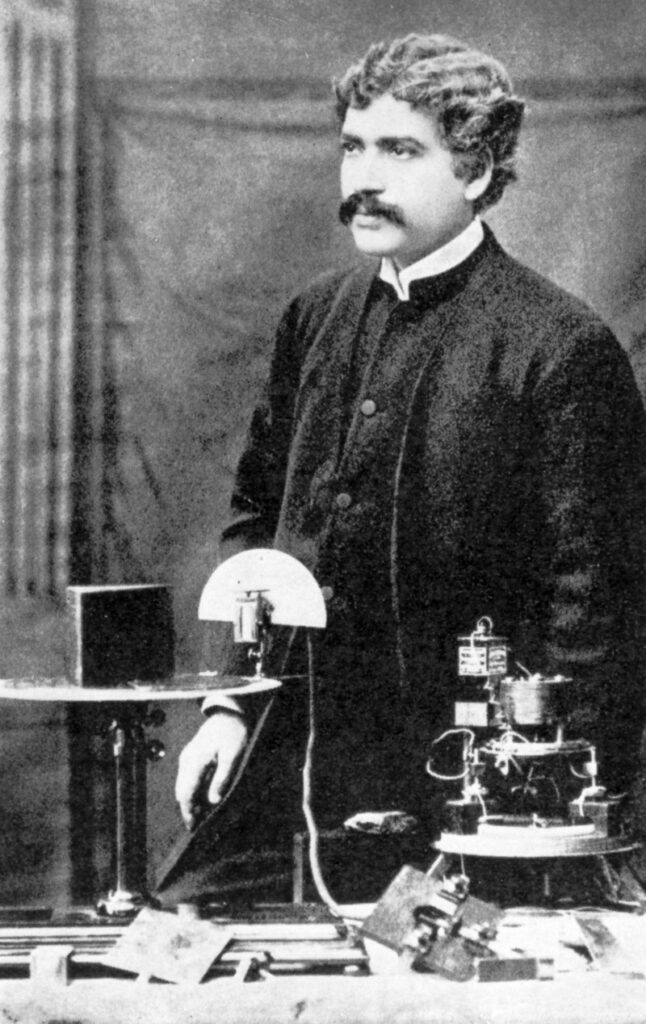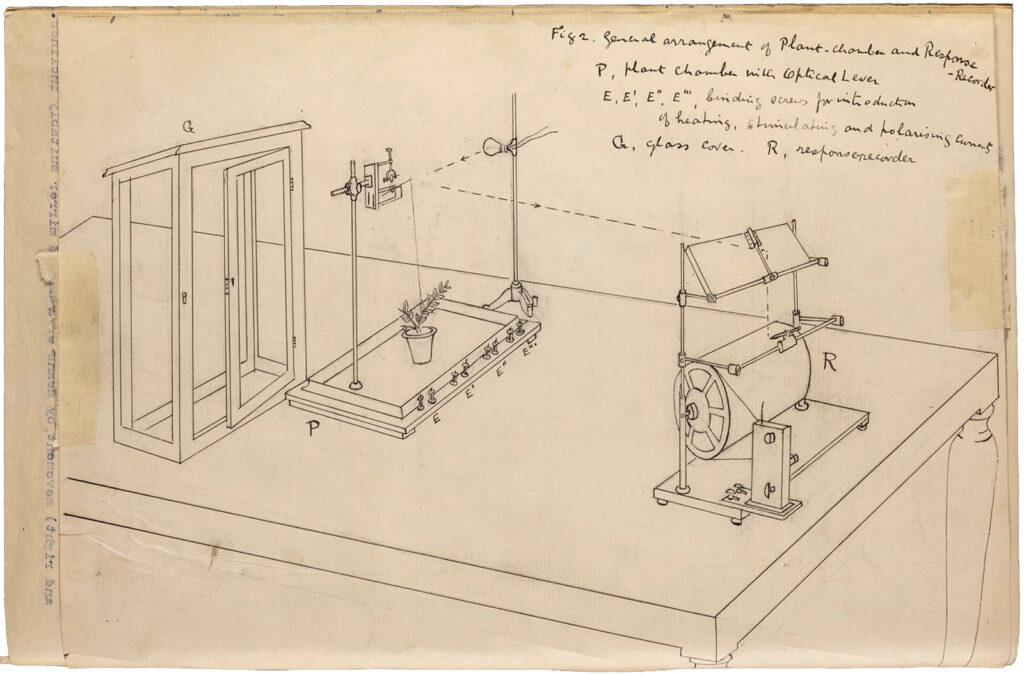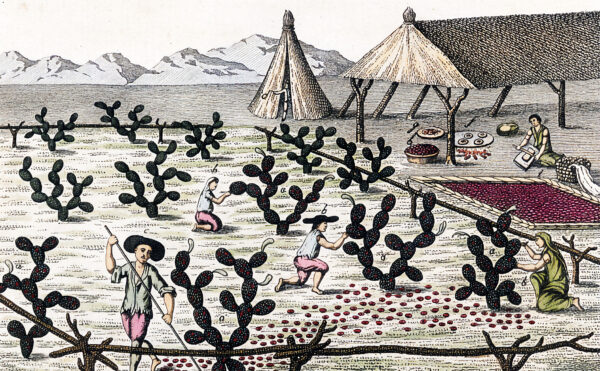In August 1926, Jagadish Chandra Bose stood before a rapt audience of scientists and showed them their kinship with plants.
Bose had traveled from India to Oxford to convince the esteemed members of the British Association for the Advancement of Science that the phenomena governing animal life weren’t restricted to animals alone.
On his way into the lecture hall, he pulled a stem of snapdragon, which he connected to an apparatus designed to trace the plant’s electrical signals onto a sensitized plate. As the crowd stood on tiptoe to better witness the demonstration, he showed them what he described as the plant’s heartbeat. In rhythm, the recording rose and fell. Placed into a tray of the sedative bromide, the stem sagged, and the line tracing its signals followed suit. Exposed to the potent aroma from a tray of musk, both appeared to revive.
As audience members leaned in, the impeccably dressed showman used another instrument to demonstrate the way sap moved through the plant—not so unlike the blood pulsing through their own bodies, he said. When the stem was exposed to a stimulant, a recorder documenting the sap’s circulation curved upward. Transferred into a depressant, it seemed to lose all signs of vitality. The spectators held their breath, absorbed in the life-and-death struggle playing out before them.
Scientific conceptions of plant life were wrong, Bose told the crowd. Plants were much more than passive automata.
In a book published the following year, he documented a series of experiments tracking the subtlest plant movements, work that made “the dumb plant the most eloquent chronicler of its inner life and experiences.” In his studies, he found that there is no reaction “in even the highest animal which has not been foreshadowed in the life of the plant.”
By that point, on the doorstep of his 70s, Bose had spent more than two decades traveling around India, Britain, Europe, and the United States to share the unity he had found in the natural world. Everywhere he went, he brought his suite of finely tuned instruments and his insistence that not only had plants developed a nervous system, but one that had “reached a very high degree of perfection.”

Bose’s experiments impressed luminaries including Albert Einstein and Lord Kelvin, but the conclusions he drew put him at odds with many leading botanists, who saw a dangerous blending of science with spirituality—and insufficient evidence to support his claims that plants were capable of intelligent behavior, learning, and memory.
One was either a “Bosephile” or a “Bosephobe,” as Stanford plant physiologist George Peirce wrote in Science in 1927. To be neutral would “indicate either a degree of ignorance or a feebleness of backbone quite deplorable.”
“They are not science, they are not knowledge,” Peirce, a Bosephobe, wrote of Bose’s studies. “They are belief, they are a philosophy of life, a guide and interpretation of conduct.”
By and large, that opinion won out. For generations, Bose’s work was dismissed as a wayward curiosity, with young investigators shooed away from taking too great an interest. Nevertheless, in recent decades Bose’s conception of the plant nervous system has taken root among a small community of scientists seeking to change how we think about plants. Some see Bose as something of a “martyred sage,” says Pace University biologist Eric Brenner. In 2006 he coauthored a paper in Trends in Plant Science that announced the formation of a new field called plant neurobiology and reignited a fire left smoldering when Bose’s perspective was quashed.
A century on, the clash between Bose and the scientific establishment echoes in modern debates over whether plants have a kind of nervous system and whether they exhibit intelligence.
For plant neurobiologists, the evidence is clear that plants are more like us than we think. For many in plant science’s mainstream, however, this proposed new paradigm is as unhelpful to scientific progress as was Bose’s own.
Everyone is still, it seems, either a Bosephile or a Bosephobe.
Born in 1858, Bose was a young boy when his family moved to Faridpur, a sweltering city along the Padma River in present-day Bangladesh. His middle-class family identified with the reformist, caste-denying Brahmo sect of Hinduism. A tinkerer from an early age, he was drawn into a scientific life by his father, a deputy magistrate who fed his son’s fascination with living things and their biological processes by introducing him to physics and botany. His father’s tutelage set Bose on the path to study in Calcutta (now Kolkata) and then England, where he attended Christ’s College, Cambridge.
Bose returned to Calcutta in 1885 to teach physics at Presidency College, becoming the first Indian appointed a professor of science. Research by homegrown scientists was unheard of before Bose. In those early years, he spent much of his time in a tiny room at the college, where he developed custom-built instruments to explore the transmission and detection of electromagnetic waves as they move invisibly through the world. His only help came from a tinsmith. At a time when European scientists were using clumsy apparatus, his devices offered a major leap forward.

In 1894, Bose discovered millimeter waves, now known as microwaves, using a handmade coherer, an instrument filled with conductive spiral springs capable of detecting radio waves. The next year he presented his discovery to an audience at Calcutta’s town hall, showing how the invisible waves travel through air just as light does. What’s more, he revealed, they could pass through wood, rock, even the human body. Flashing the flair for entertainment that would become a hallmark, he sent microwaves speeding invisibly across the room through three stone walls and the governor of Bengalbefore they reached a coherer placed 75 feet away. Upon their arrival the waves triggered a ringing bell and—BANG—a loaded pistol.
For the next two years the Indian government sent Bose on a lecture tour of England and Europe, where he demonstrated his discovery and instruments. His presentations were lauded by surgeon Joseph Lister and Kelvin, who urged India’s government to build Bose a laboratory and better support his experiments in radio communication. Even the most staid British newspapers called him “strikingly original” and “sensational”; the Royal Society and prestigious journals began regularly publishing Bose’s research. (The Institute of Electrical and Electronics Engineers still awards a medal in Bose’s name for wireless communication innovations.)
But something Bose saw while using his coherer changed the course of his career. The coils inside his device appeared to exhibit fatigue in the form of a diminished sensitivity to radiation as his experiments wore on. Allowed to rest for a few hours, the instrument recovered its strength, much like an animal muscle would. Bose, who was inclined to see unity all around him, concluded that organic muscle and inorganic metal respond similarly to stimuli. What he saw, he believed, blurred accepted boundaries between the living and nonliving.
Bose decided to unveil his findings at the Paris Exposition of 1900, where over the course of seven months more than 50 million visitors came to celebrate the scientific, technological, and artistic achievements of the past century and anticipate those of the next. Bose was one of just two Indian delegates among some 80,000 international participants, and the lone Indian invited to present at the International Congress of Physics, the field’s first large international conference, hosted at the Sorbonne.
There Kelvin held court on the constitution of ether, while other speakers addressed the measurement of the velocity of sound and light, the theoretical laws of radiation, and the gravitational constant. But none was proposing anything more revolutionary than Bose’s audacious realignment of the natural order.
At a session on electricity and magnetism chaired by soon-to-be Nobel Prize winner Pierre Curie, Bose told an enthralled audience that there is “no break of continuity” between the living and nonliving. No line could be drawn to separate the “phenomena of dead matter” from those “peculiar to the living.” He questioned whether the apparent inertness of metal was actually an incapacity to see its response and suggested that the diversity of matter belied its fundamental unity.

A secretary of the congress, taken by what he had heard, asked Bose to carefully detail his “beautiful” findings so they could be translated into French. German physicist Emil Warburg lamented that Bose had left little for others to learn about the coherer. Bose, living in London for a stint, was buoyed by the response and poured himself into his investigations.
In May 1901, Bose lectured at the Royal Institution before an audience of more than 350 scientists. It was a chance to share more widely the unity he had found. At the demonstration, he pinched a muscle (the animal is not clear) and watched as a galvanometer traced the response. The electricity coursing through it was evident. Then, he did the same with a metal wire, twisting one end and recording a similar response. In plants, too, he demonstrated responses to fatigue, changes in temperature, and exposure to chemicals. The audience gasped at the similarity among the graphs his instrument produced.
“Do not the records show us,” he asked, “that the responsive processes, seen in life, have been foreshadowed in nonlife?”

The crowd gathered around his table afterward, eager to look at his instruments. William Roberts-Austen, an esteemed metallurgist, was overjoyed by what he saw. “I have all my life studied the properties of metals,” he said. “I am happy to think that they have life.”
Not everyone was so enamored. The Globe, a London daily, mocked Bose with the image of homemakers “petting the fire-irons.” The Daily Mail sarcastically suggested opening a society for the preservation of cruelty to metals.
Some scientific witnesses also snickered. Physiologists who occupied the “highest thrones in the kingdom of physiology,” by Bose’s own estimation, attacked his work.
John Burdon-Sanderson, recognized for his studies of electrical phenomena in the Venus flytrap, took umbrage with Bose’s claim that ordinary plants—not just those known to be sensitive to touch—exhibited “electrical response.” Burdon-Sanderson, who had spent unsuccessful years trying to detect such a universal sensitivity, leapt on Bose’s interpretation, shaming him for describing a “response” rather than a “reaction,” and so affording plants too much agency. It was “a great pity,” he sniped, that Bose had left physics behind.
Augustus Waller, a lecturer in physiology at St. Mary’s Hospital in London and a former student of Burdon-Sanderson, joined the attack. Waller was the first to record the heart’s electrical activity and obtain its electrocardiogram. Like Burdon-Sanderson, he used live animals in his experiments and was threatened by both a growing anti-vivisection movement and Bose’s suggestion that plants might hold the solution to “the intricate problems of animal life.” Bose had visited Waller’s laboratory earlier that year, admiring his ingenuity. Apparently the respect wasn’t mutual.
When Bose submitted a paper on his response studies to the Royal Society, Waller, like his mentor, urged its rejection. Bose wasn’t helped by accusations that he had cribbed some of Waller’s research during his visit and claimed it as his own. The resulting dustup earned Bose the distrust of the scientific establishment and an enemy in Waller, who responded with savage commentaries on Bose’s ensuing papers.

In a matter of months, the respected physicist morphed into a controversial physiologist in the eyes of many. The Royal Society elected not to publish Bose’s work on electrical response in plants nor any other research for more than a decade. Bose lamented that by entering a “border region” between physics and physiology, he had “unwittingly strayed into the domain of a new and unfamiliar caste system.” Once self-assured enough to carry his country’s scientific reputation on his shoulders, the rejection destabilized him.
“No conditions could have been more desperately hopeless,” he wrote, “than those which confronted me for the next 12 years.”
In the wake of the controversy with Waller, Bose retreated to Calcutta and stopped submitting papers for publication rather than contend with the enmity of those reviewing them. Instead, he began sharing his findings in books, expanding his popular audience even as he distanced himself from his scientific peers.
Although his critics claimed his work failed to meet scientific standards, few, if any, had access to instruments that matched his in sophistication or sensitivity. Compared with humans, plants’ movements are exceedingly slow and minute; measuring them requires instruments capable of tremendous magnification and fine calibration. Bose’s arsenal managed the feat with apparent ease.

On a visit to India in the 1920s, writer and philosopher Aldous Huxley marveled at the intricate machines Bose had crafted from little more than needles, filaments, clockwork, and smoked glass. He watched Bose put his plants through their paces, tracing their growth and response to electric shock. One device rang a bell when the plant’s exhaled oxygen reached a certain level; to Huxley’s amusement, adding a stimulant to the water in which the plant was standing “set the bell wildly tinkling.” As he saw it, Bose’s instruments afforded humans the “microscopical acuteness of vision” to understand plants’ sensitivity—and to regard them as more than just matter.
“Being only a literary man and not one of those physicists, whose professional interest it is to keep matter in its place, I am delighted,” he wrote.
With his inventions, Bose studied both touch-sensitive subjects, such as Mimosa pudica (the shameplant or sensitive plant) and Codariocalyx motorius (the telegraph or dancing plant), as well as so-called “ordinary” plants including carrot, radish, and geranium. Everywhere he looked, plants “fulfill[ed] the test of vital phenomenon.”
Bose wasn’t the first to investigate plants’ ability to sense their environments. Burdon-Sanderson had recognized nerve-like activity in the Venus flytrap in the 1870s. Charles Darwin had written in 1880’s The Power of Movement in Plants that a plant’s roots act “like the brain of one of the lower animals.” And electrophysiologists in the United States and Sweden were exploring bioelectricity, including the measurement of action potentials—rapid changes in voltage across a cell membrane—in algae.
But Bose was both a forerunner and a public figure drawing significant attention. He was also the first to use the term “plant nerve” and the first to regard all plants as active and exploratory organisms with capabilities resembling our own. In doing so, he became a target for a scientific establishment unmoored by his declarations and style. His writing regularly afforded agency to his subjects that his contemporaries were loath to extend.
“Trees have a life like ours,” Bose wrote. “They eat and grow, . . . face poverty, sorrows and suffering. This poverty may . . . induce them to steal and rob. . . . They also help each other, develop friendships, sacrifice their lives for their children.”

Many of Bose’s opponents, particularly Burdon-Sanderson and Waller, belonged to a breed of late-Victorian mechanistic materialists. Physiology in their era was organized around ideas that reflected Descartes’s concept of the bête-machine, or beast-machine—the notion that nonhuman animals are a complex of mechanisms lacking consciousness. Plants, in their worldview, were passive collections of matter, not sensate beings. These researchers held that nonhuman life could be reduced to the laws of physics. Their experiments deconstructed biological mechanisms into their simplest forms to be studied in isolation. Most living things were, effectively, nothing but the sum of their parts.
Bose saw the relationship between matter and life differently. His monotheistic strain of Hinduism professed that a universal spirit was manifest in all things. In scientific circles, this put Bose in the camp of vitalists, who imagined a universal “vital spark,” distinct from any chemical or physical forces, that animated living things. Bose didn’t hide his spirituality. The epigraph to his first book quoted the Rig Veda, a sacred Hindu text, and when the Bose Institute was established in Calcutta in 1917 (a response, finally, to Kelvin’s plea), Bose introduced it as “not merely a laboratory but a temple.”
In the simplest terms, the opposing camps’ worldviews were incompatible. And considered against the backdrop of the creationist movement threatening science in the 1920s, Sharon Kingsland, a historian of biology at Johns Hopkins University, says it’s understandable that scientists felt the urge to defend their expertise against Bose’s hybrid of science and spirituality.

Bose’s style itself also brushed up against a school of botanists trained in the model of Julius von Sachs, the so-called father of plant physiology. Von Sachs’s followers were careful about the use of metaphors to describe or explain their experimental findings, fearing they would be taken literally, Kingsland says. Among these contemporaries, there was little room for what Bose himself described as “the inherent bent of the Indian mind towards mysticism and unchecked imagination.”
“There was always something in his thought that was going to bump up against scientific orthodoxy,” Kingsland says.
Richard Goldschmidt, a German geneticist who visited Bose at his institute in Calcutta, joined a parade of critics who derided him through the latter stages of his career, branding him a “fake” and mocking him for having “discovered the soul of plants.” Daniel MacDougal, director of the influential Desert Laboratory in Tucson, Arizona, declared that “pulsations, heart-beats and nerves in plants are sheer nonsense with no scientific foundation whatever.” He pledged to “protect the American public” from Bose’s “infantile fancies,” and rallied others to the cause. Peirce, the Stanford plant physiologist who divided the field into Bosephiles and Bosephobes, called Bose’s 1927 Plant Autographs and Their Revelations a book “as dangerous as it is fascinating.”
Bose’s scientific contemporaries also struggled to replicate his experiments, perhaps because they lacked his skill with instrumentation and perhaps because Bose’s sketches lacked the detail that would have aided their efforts.Soon, the chorus of voices unwilling to accept his interpretations grew to a fever pitch. It didn’t help that Bose, despite his frequent international lectures, was largely isolated in India, eschewing collaboration with Western scientists as he pursued his own ideas, Kingsland says. He was often out of touch with the science developing beyond his own laboratory.
“He was working on this intellectual project, and over time rather than become more integrated with the biological community he became more and more alienated from it,” Kingsland says.

Bose, “a poet in the world of facts,” as the Bengali polymath Rabindranath Tagore called him, couldn’t surmount the wave of opposition. He remained a hero to many in India and was eventually knighted and elected to the Royal Society, but in the scientific West he was eventually cast aside. In the end, the Bosephobes won the day.
As he aged, Bose grew impatient, irritable, insensitive. He began to rebuke his students and the staff at the Bose Institute, which he directed until his death in 1937. Once a spirited explorer with a capacious sense of kinship, he died, in the eyes of one Indian critic, a “lapsed scientist and half-forgotten mystic.”
For decades after his death, Bose was relegated to the sidelines of plant science, even as botanists continued to explore how plants respond to their environment. Though absent from textbooks, his ideas and the poetic way he expressed them have never been fully forgotten, even if those carrying his torch have faced familiar resistance in doing so.
When in 2006 Brenner and his colleagues introduced plant neurobiology, a field “as new as it is old,” they acknowledged Bose as the first to identify the ubiquitous importance of electrical signaling.
“The goal of plant neurobiology,” their paper read, “is to illuminate the structure of the information network that exists within plants.” Among the pressing issues ripe for investigation was the “cryptic function of long-distance electrical signals and their poorly understood role in regulating plant responses.”
The paper boldly disrupted the status quo among plant scientists, most of whom had long since set aside any work that interrogated the existence of a plant nervous system. Such investigations had been inhibited by “self-censorship,” the paper argued, in the wake of The Secret Life of Plants, a controversial 1973 book that blended plant science with pulp fiction.
The book, written by a pair of former spies who speculated elsewhere on mystical theories about the pyramid at Giza and the art of dowsing, made a spate of pseudoscientific claims that, in the eyes of many researchers, bordered on quackery. Using uncontrolled experiments, random observations, and anecdotal reports, the book’s authors made the case that plants have emotions and extrasensory perception, and that they can read minds and recognize violence in their midst. A dissection in American Scientist called it a “corpus of fallacious or unprovable claims.” Still, it became a best-seller, spawning a documentary scored by Stevie Wonder, fresh off Songs in the Key of Life.

A section of the book devoted to Bose called his work “so much in advance of his time it could not be precisely evaluated.” It was the only piece that evaded scorn from American Scientist. “In retrospect, Bose certainly does deserve great credit,” the critics wrote, even if other plant electrophysiologists made some of his work look “primitive” in time.
In the book’s aftermath, as biologist Eric Davies put it, electrical signaling “became to botany what astrology is to astronomy.” Research funding dried up, and anyone searching for the plant nervous system was deemed a crank. Nonetheless, evidence of its existence slowly continued to mount.
In 1992, a paper published in Nature offered what its authors called a “conceptual breakthrough.” Tomato plants use electrical signals to alert their defense system to the presence of grazing caterpillars, they found. When a leaf is chewed, it warns its neighboring petioles to begin producing unsavory chemicals that deter the insects.
“Plants found to send nerve-like messages,” the New York Times declared, drawing an analogy long considered taboo by botanists. Plant physiologist David Wildon, one of the paper’s authors, took it a step further. “Everyone can see now that if you find a system in animals and you look for it in plants, it turns up,” he said, echoing Bose if not naming him.
By 2006, plant scientists had linked electrical signals to respiration and photosynthesis, pollination, the transport of resources through phloem, and the deployment of plant defenses. Still, the suggestion that these functions are part of some kind of nervous system remains anathema to the mainstream. Within a few years, the Society for Plant Neurobiology, facing backlash over how its members interpreted these scientific developments, changed its name to the less contentious Society for Plant Signaling & Behavior.
Lincoln Taiz, who co-authored with Kingsland a paper in Protoplasma on the plant intelligence debate, has said that plant neurobiologists suffer from “anthropomorphizing, philosophizing, and wild speculations”—all allegations lodged at Bose a century ago. Peter Minorsky, a biologist who has written about the plant neurobiology revolution and Bose’s reception in the West, accused Kingsland and Taiz of “presenting specious and straw arguments” and “purposefully mischaracterizing” scholars’ statements.

For two decades now, the disputing sides have fired barbs back and forth in academic papers and public commentary, revealing a polarized field of study well suited to our polarized times. The tension has threatened to overshadow the real strides that have been made in understanding plant signaling in that time. The two camps seem, at times, to be speaking past one another. Some researchers feel compelled to guard their curiosity or limit it altogether. When Brenner tells other scientists he’s interested in searching for what he tactfully calls a plant’s “central integrative unit,” the conversation often ends instantly, he says.
“Do plants have brains? No, nobody’s saying plants have brains,” Elizabeth Van Volkenburgh, a retired plant biologist at the University of Washington and coauthor of the 2006 paper, says. “Do plants have agency? This is the big question.”
In response to an early letter denouncing plant neurobiology, plant physiologist Anthony Trewavas said the name of the nascent field wasn’t meant to be taken literally, but rather to promote a more expansive way of thinking about plants. “Metaphors help stimulate the investigative imagination of good scientists,” he wrote.
But all that imagination hasn’t helped modern Bosephiles convince their skeptics any more than it helped Bose himself.
“If we know more about plant physiology and plant genetics, it comes from regular scientific approaches. You don’t really need this level of metaphor to make those discoveries,” Kingsland says. “At some point the metaphor becomes an encumbrance, rather than something helpful.”
For Bose, there was nothing to fear in contemplating the similarities between plants and animals, whether literal or figurative. But he, too, recognized the only way to overcome our profound ignorance about the mechanisms of plant response was to set aside “contending and irreconcilable theories” and listen to the plants themselves.
“The only clear path is that which leads us away from the din of disputation to follow the trail of fact,” he wrote in Plant Autographs. “We must therefore abandon all our preconceptions and put our questions directly, insisting that the only evidence which can be accepted is that which bears the plant’s own signature.”




